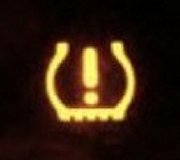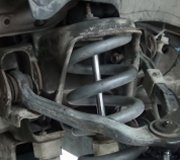That tire wear might or might not be related but it is not normal. First you have to look at the other tire to see if it has the same wear. If it does, the "total toe" is misadjusted. That means the fronts of the two tires are closer together than the rears and they are scrubbing going down the road. That makes the leading edge wear down. To exaggerate it for clarity, imagine the right front tire turned to the left, ... More, and more, until it is at 90 degrees to the car. It can't really turn that far, but now it's easy to visualize that the outside edge is toward the front of the car, and is the "leading edge". Now compare that to pencil eraser. Hold the pencil straight up with the eraser end down and on the table. Put a little downward pressure on the eraser, then drag the pencil sideways across the table. You'll see the leading edge scrub off and make eraser crumbs, but the trailing edge lifts off the table and no wear takes place. That's what's happening to your tires when total toe is not adjusted to specifications.
The additional clue to a toe problem is that high and low area occurs on each block of rubber tread. Each block will have a high, unworn side and a low, worn side. As you rub your hand over them one way your fingers will move smoothly even though you'll feel the unevenness, but if you rub your hand the other way, your fingers will catch on the raised spots. It's similar to running your fingers both ways along the teeth of a round saw blade. Smooth one way, sharp the other way.
If that wear is only taking place on the one tire, that's a lot easier to describe. "Camber" is a different alignment angle that has to do with the inward or outward tilt of the wheel as viewed from in front or back of the car. If the right tire has too much positive camber, it is leaning out on top. That will cause it to run on the outer edge which will wear faster. Some clues are that only affects that one tire, and camber makes a tire want to roll in the direction it's leaning so your right tire wants to pull the car to the right. You will notice that as the car going to the right when you let go of the steering wheel. Camber wear also leaves that worn part of the tire smooth, not with raised and low areas on each block of tread.
Taking the shaking and tire wear together, a sloppy wheel bearing comes to mind although if bad enough, that will usually cause the wheel to tilt in on top, not out. But being front-wheel-drive, that would also cause that tire to turn left under acceleration. That could account for the outer tire wear, and being sloppy, the entire hub and wheel would shake back and forth.
A tire and alignment specialist should have no problem finding the cause when there are so many clues to look at. Have the steering and suspension systems inspected by a different shop if the first one can't figure it out.
Friday, July 22nd, 2011 AT 11:26 PM



